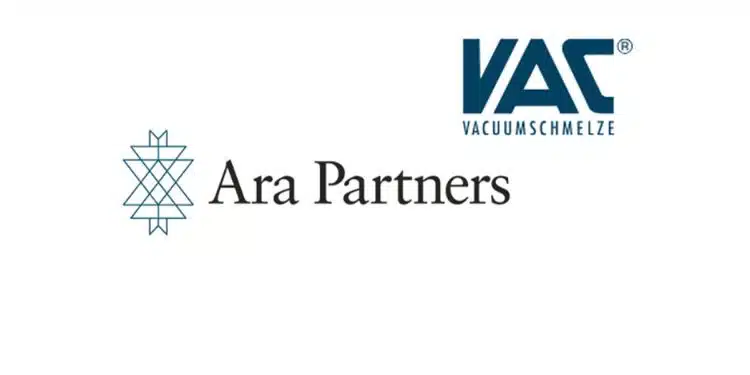Ara Partners (“Ara”), a private equity firm that specializes in industrial decarbonization investments, today announced that it has acquired Vacuumschmelze (“VAC”), a leading global producer of advanced magnetic materials and the largest producer of rare earth permanent magnets in the Western Hemisphere, from funds managed by Apollo. Terms of the transaction were not disclosed.
VAC is a vertically integrated magnetic solutions provider that designs and manufactures mission-critical soft and hard magnetic materials for a wide variety of industrial applications across the automotive, renewable energy, industrial automation, medical and aerospace sectors. VAC is poised to meet the significant and growing global demand for hard-to-replace, high-quality magnetic materials critical to the energy transition given its more than 100-year history of excellence in commercial innovation, hundreds of patents protecting its robust technical know-how and tailored product designs, and longstanding partnerships with industry-leading blue-chip customers. VAC is headquartered in Germany, with manufacturing facilities in Slovakia, Finland, China, and Malaysia.
VAC is the only Western manufacturer of sintered NdFeB EV-grade permanent magnets. In January 2023, VAC entered a long-term agreement with General Motors (“GM”) to build a facility in North America to manufacture permanent magnets, using locally sourced raw materials, to supply the electric motors used in a broad portfolio of GM electric vehicles. Through permanent magnet sales for use in EVs alone, VAC has the potential to catalyze the abatement of a gigaton of CO2E in the next five years.
Tuan Tran, Partner at Ara Partners, commented, “We are thrilled to acquire VAC, the premier Western producer of high-performance magnetic materials and a key enabler of electrification and energy
efficiency across massive global industries. We believe the demand for VAC’s differentiated, customized products will continue to grow rapidly as companies around the world decarbonize their industrial processes and the electrification of mobility advances, and we look forward to leveraging our expertise to further enable VAC’s continued success. We are excited to collaborate with Erik Eschen and VAC’s talented, deeply experienced management team, and to support the company’s next stage of growth as it expands its manufacturing capabilities in North America to drive the decarbonization of transportation.”
Erik Eschen, Chief Executive Officer of VAC, said, “We are excited to partner with Ara Partners, which has a strong track record of working closely with management teams across the industrial economy to create value while achieving meaningful decarbonization benefits. Ara and VAC will capitalize on significant growth opportunities for soft and hard magnetic solutions alongside our loyal partners and customers. In addition, we will accelerate work towards building our rare earths value chain, pursuing a range of strategic growth opportunities to establish a robust supply chain for EV manufacturing in the Western World.” Latham & Watkins LLP acted as legal counsel to Ara Partners. Barclays acted as financial advisor to VAC. Paul, Weiss, Rifkind, Wharton & Garrison LLP and Ashurst LLP acted as legal counsel to VAC.
About Vacuumschmelze
VAC is a leading global producer of advanced magnetic solutions, rare earth permanent magnets, and inductive components that are crucial for the decarbonization of our planet. With more than 100 years of application know how and experience in material science and product development, VAC designs and manufactures mission critical solutions for a wide variety of industries, including renewable energy, e-mobility, automotive, industrial automation, medical, aerospace and defense. VAC’s unique ability to develop and manufacture from base elements through final products enables us to provide customers optimal form factors and performance, generating best in class efficient solutions in an environmentally conscious manner.
About Ara Partners
Ara Partners is a private equity firm focused on industrial decarbonization investments. Ara Partners invests in the industrial and manufacturing, chemicals and materials, energy efficiency and green fuels, and food and agriculture sectors, seeking to create companies with significant decarbonization impact. It operates from offices in Houston, Boston and Dublin, Ireland. As of June 30, 2023, Ara Partners had approximately $4.4 billion of assets under management.































